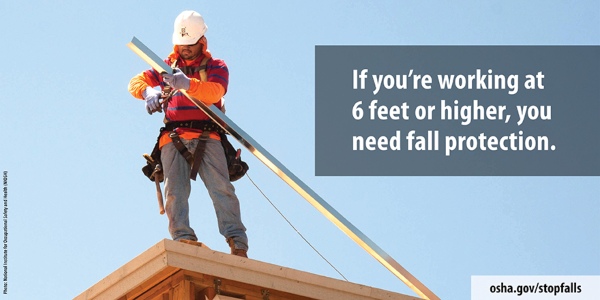Understanding OSHA’s Fall Protection Standards: Part One

The Occupational Safety and Health Administration (“OSHA”) requires contractors, particularly roofing contractors, to use fall protection in the workplace.
Historically, falls are the leading cause of fatalities in construction. In this three-part article, we will first discuss a general overview of OSHA’s fall protection standards along with examples of fall protection requirements for certain construction activities. Part Two will lay out the different types of conventional fall protection systems, and finally, in Part Three, we will describe other hazards that may require fall protection.
29 C.F.R. § 1926.500-503 (“Subpart M”) outlines the requirements and criteria for fall protection in construction workplaces. Upon the start of a project, employers should assess the jobsite to determine whether fall protection is required. Subpart M requires the use of fall protection when employees are working at heights of 6 feet or greater above a lower level. If fall protection is required, then employers should identify which type of fall protection system to implement. Generally, fall protection can be provided through the use of guardrail systems, safety net systems, or personal fall arrest systems. However, depending on the work, OSHA may require a certain fall protection system. For example:
-
Leading Edge – 29 CFR § 1926.501(b)(2)
“Leading edge” means the unprotected side and edge of a floor, roof, or other working surfaces which changes location as additional floor, roof, or decking are constructed. Each employee constructing or walking on a leading edge 6 feet or more above a lower level must be protected by guardrail systems, safety net systems, or personal fall arrest systems.
-
Roofing Work on Low-Slope Roofs – 29 CFR § 1926.501(b)(10)
A low-slope roof has a slope less than or equal to 4 in 12. Put simply, the roof rises 4 inches for every 12 inches (1 foot) of run. When engaged in roofing on a low-slope roof that has one or more unprotected sides, employers may use:
-
Guardrail systems;
-
Safety net systems;
-
Personal fall systems;
-
A combination of one of the prior and a warning line system; or
-
A warning line system and a safety monitoring system.
-
Working on Steep Roofs – 29 CFR § 1926.501(b)(11)
A steep roof has a slope greater than 4 in 12. When working on a steep roof that has one or more unprotected sides, employers may use:
-
Guardrail systems with toeboards;
-
Safety net systems; or
-
Personal fall arrest systems.
In sum, employees working on a surface 6 feet or greater than a lower level must be protected by some form of fall protection. If the employer can show a fall protection system is infeasible or creates a greater hazard to their employees, the employer must develop and implement a site-specific fall protection plan which meets the requirements of 29 CFR § 1926.502(k). Typically, determining whether fall protection is required is easy, but determining which type of fall protection is best for your jobsites can be difficult. In Part Two, we will discuss each type of conventional fall protection system along with their advantages and disadvantages.
Disclaimer: The information contained in this article is for general educational information only. This information does not constitute legal advice, is not intended to constitute legal advice, nor should it be relied upon as legal advice for your specific factual pattern or situation.
Cotney Construction Law is an advocate for the roofing industry and General Counsel of NRCA. Its attorneys’ practice in all areas of construction law. The firm works extensively on matters relating to OSHA defense, which includes the management and development of safety and health strategies for construction contractors across the United States. The firm’s OSHA practice concentrates on litigation and the appeals of citations involving catastrophic construction related accidents. For more information, please visit www.cotneycl.com.




-2025-xtv-mls-tour-2.png)


















Comments
Leave a Reply
Have an account? Login to leave a comment!
Sign In